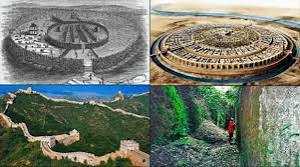The heart of Nigeria lies a monumental testament to human ingenuity and resilience—the Great Walls of Benin, which total length is approximately 10,000 miles. This architectural design is recognized as the world’s largest manmade structure by length, constructed over several centuries, from 800 AD to 1460 AD, the walls encapsulate the historical and cultural richness of the Benin Kingdom, which flourished during this period.
A Legacy of Perseverance: 150 Million Man-Hours
The scale of the Great Walls of Benin is remarkable, not only for their impressive length but also for the sheer effort expended in their construction. It is estimated that the project required about 150 million man-hours of labor.
This monumental task was carried out by skilled artisans, laborers, and the local community, who worked collectively to create interconnecting walls that served as both a defensive barrier and a symbol of power and prestige for the Benin Empire.
The walls were made from earth, laterite, and other local materials that were readily available, showcasing the resourcefulness of the builders. These structures, designed to protect the city of Benin from external threats, also reflected the advanced engineering and architectural knowledge of the time.
The Historical Significance of the Walls
The Great Walls of Benin did much more than provide physical protection; they stood as a representation of the political strength and organizational ability of the Benin Kingdom.
At their height, the walls encircled the city of Benin, which was the capital of a civilization known for its sophisticated governance, trade networks, and artistic achievements. The walls not only shielded the inhabitants but also reinforced their cultural identity in a rapidly changing world.
The Benin Kingdom was known for its rich traditions, including the famous Benin Bronzes, intricate artifacts that resonated with the history and stories of the people.
The Tragic Destruction
Despite it significance, the Great Walls of Benin ultimately faced destruction during British colonial incursions in the late 19th century. In 1897, British forces invaded and looted the city, leading to the dismantling of the great walls, which had stood for nearly a millennium.
This act was part of a broader pattern of colonial oppression that sought to undermine indigenous structures of power and governance. Also, the subsequent years saw the diaspora of artifacts, including the iconic Benin Bronzes, as they were taken to museums in the West, often with little regard for their rightful ownership.
A Legacy Reclaimed
Today, efforts are being made to recognize and preserve the history of the Great Walls of Benin and the civilization that constructed them. Scholars and historians are working diligently to document this rich heritage and advocate for the return of artifacts taken during the colonial period. The narrative of the Great Walls is gradually being retold, fostering a renewed sense of pride and identity among the Benin people.
The walls, although now in ruins, but still reflects on the complexities of history, the dynamics of cultural exchange, and the enduring spirit of communities that have faced adversity yet stand unyielded in the face of change.
Conclusion
The Great Walls of Benin should be celebrated not just as a physical structure but as an emblem of human persistence and creativity. Measuring an extraordinary 10,000 miles in length and requiring an estimated 150 million man-hours to build, these walls encapsulate a story of a rich eye opener that contributed significantly to Africa’s culture and history.
As the world continues to understand the narratives of ancient empires, the legacy of this artwork remains a vital thread in the story of humanity. Although, the walls may have fallen, but their spirit endures, echoing through the ages as a symbol of resilience, strength, and pride.
Video link
https://www.facebook.com/share/r/2bRG36yB3G3a8p8N/?mibextid=wwXIfr











